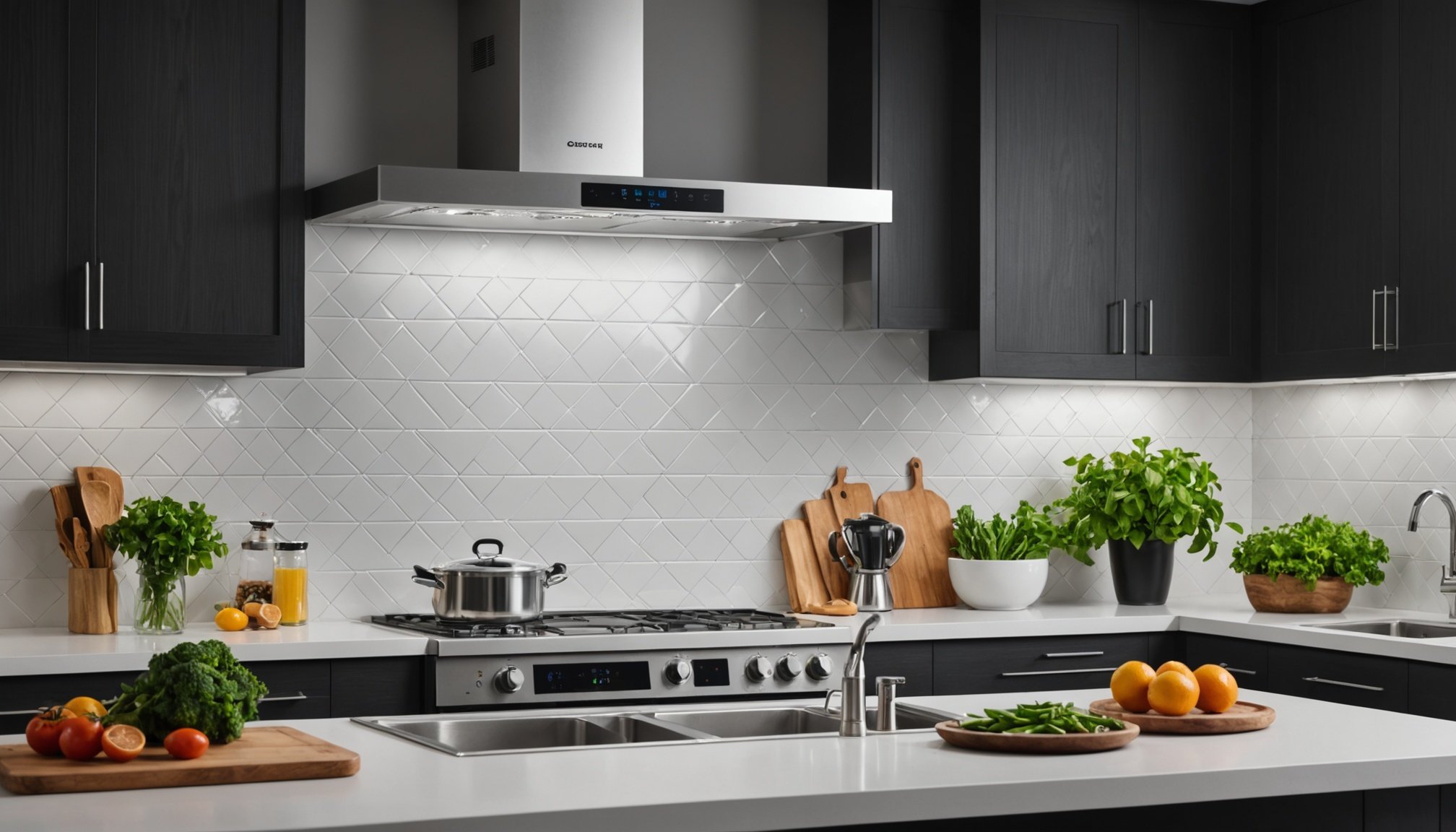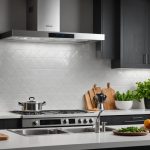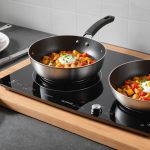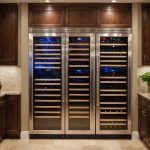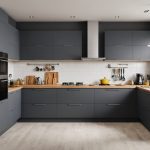Understanding UV-C Air Purifiers
UV-C technology plays a pivotal role in air purification, targeting airborne contaminants to improve indoor air quality. This method uses short-wavelength ultraviolet light with germicidal properties that disrupt the DNA and RNA of viruses, bacteria, and other pathogens. By impairing their reproduction, UV-C air purifiers effectively reduce infection spread within enclosed spaces.
The functioning of UV-C air purifiers involves drawing air into the unit, exposing it to UV-C light, and then circulating the purified air back into the environment. Kitchen environments, with their heavy reliance on heated appliances and food preparation processes, can greatly benefit from enhanced air quality measures. By eliminating microorganisms and pollutants, UV-C purifiers maintain a healthier atmosphere, crucial for areas where food is prepared and consumed.
Also to discover : Discover the advantages of induction cooktops: save energy and cook healthier meals effortlessly!
Furthermore, good indoor air quality fosters better health outcomes and ensures a more pleasant living experience. Individuals with respiratory issues, allergies, or compromised immune systems are particularly at risk when exposed to poor air quality. Hence, the use of UV-C air purifiers in maintaining and enhancing indoor air standards is essential, particularly in spaces with significant pollutant potential, such as kitchens.
Health Advantages of UV-C Air Purifiers
Understanding the health benefits of UV-C air purifiers can significantly enhance your well-being. These devices are designed to improve respiratory health by reducing airborne pollutants, such as viruses, bacteria, and other pathogens, which can provoke respiratory conditions.
Have you seen this : Enhance food safety and nutritional value in your kitchen with uv light sanitizers
UV-C technology excels in offering allergy relief, making it an excellent choice for individuals who frequently suffer from allergies. By neutralizing common allergens like dust mites and pet dander, UV-C air purifiers create a safer environment for allergy sufferers. This is particularly beneficial for families with children or elderly members who are more vulnerable to indoor air pollutants.
Individuals with asthma can experience a marked improvement in their respiratory health by using UV-C air purifiers. These purifiers help to lower the concentration of asthma triggers, leading to fewer attacks and overall better health management.
In the long run, improved indoor air quality results in substantial health gains. Consistent exposure to cleaner air can prevent long-term respiratory ailments, contributing to better overall health. Incorporating UV-C air purifiers into your home or office not only benefits immediate health but also safeguards against future respiratory complications, offering a proactive approach to maintaining a healthy lifestyle.
Harmful Contaminants Eliminated by UV-C Air Purifiers
UV-C air purifiers are renowned for their ability to neutralise harmful contaminants in the environment. Particularly effective against bacteria and viruses, these devices are invaluable in maintaining a clean and healthy atmosphere, especially in areas like the kitchen, where pathogens often thrive.
Common Kitchen Contaminants
Cooking activities release various irritants and microscopic organisms. UV-C air purifiers effectively target cooking fumes, smoke particles, and grease-laden vapours. By targeting such contaminants, they maintain a cleaner and more breathable indoor environment.
Effectiveness Against Bacteria and Viruses
UV-C light disrupts the DNA of bacteria and viruses, preventing them from replicating. It is proven highly effective in treating these microorganisms, leading to significant reductions in their presence. This process, known as photolytic degradation, ensures that harmful pathogens in the air are not just captured but fully deactivated, hence enhancing indoor air quality.
Other Allergens and Particles Reduced Through UV-C Purification
Additionally, UV-C purifiers contribute to reducing allergens like pollen, pet dander, and dust mites. By incorporating this technology, users can enjoy relief from allergy symptoms and improve overall respiratory health. Thus, UV-C air purification proves to be a comprehensive solution for a cleaner, safer home environment.
Selecting the Right UV-C Air Purifier for Your Kitchen
Selecting the ideal UV-C air purifier involves understanding several crucial aspects that can make a significant difference in performance and value. When diving into this buying guide, it’s crucial to focus on key features such as the purifier’s filtration system, noise levels, and energy efficiency. These factors ensure you get a product that enhances air quality without unnecessary disturbances or excessive power consumption.
Different purifiers suit kitchens of various sizes, so comparing capacity and effectiveness is essential. A small kitchen might only require a compact unit with average airflow, while a larger space would benefit from a model with a higher clean air delivery rate (CADR). Understanding how these measurements relate to your kitchen’s dimensions aids in making an informed product selection.
Budget considerations are also important, as they guide the range of options available. Fortunately, many reputable brands offer models across a wide price spectrum without compromising on key features. Some prominent names in the market include Dyson, GermGuardian, and Levoit, each known for their distinct advantages, from whisper-quiet operations to innovative design. Choosing wisely ensures a balance between cost, quality, and outcome, transforming your kitchen into a cleaner, safer environment.
Best Practices for Using UV-C Air Purifiers
To fully benefit from UV-C air purifiers, it’s important to understand proper usage and maintenance.
Recommended Placement
Positioning is key. In the kitchen, place the UV-C air purifier away from direct sunlight and heat sources to prevent any reduction in efficiency. The purifier should be situated at least a couple of meters away from cooking appliances to avoid heat-induced damage. Keeping it in an unobstructed area allows for optimal airflow and maximizes its potential to improve air quality.
Maintenance Tips
Regular maintenance ensures the unit remains effective over time. First, replace the UV-C bulbs according to the manufacturer’s instructions, usually every 6 to 12 months, as they gradually lose intensity. Clean filters and chambers quarterly to remove dust and particles, maintaining purifier efficiency.
Usage Guidelines
For best results, operate your UV-C air purifier continuously, as intermittent use can significantly reduce air quality benefits. Adjust the settings based on room size; larger areas may require higher fan speeds. Always follow the usage guidelines in the manual to avoid overworking the unit, which could diminish its lifespan.
Following these maintenance tips and guidelines helps secure both the longevity of your device and the purity of your air.
Comparing UV-C Air Purifiers with Other Methods
The realm of air purification methods is vast, often leaving consumers baffled about which to choose. Among these, HEPA filters, activated carbon, and ionizers are frequently discussed. HEPA filters are celebrated for capturing up to 99.97% of particles as small as 0.3 microns. They are exquisite for those who suffer from allergies since they effectively trap dust, pollen, and pet dander. However, HEPA filters don’t remove odors or volatile organic compounds (VOCs), limiting their cleansing scope.
Ionizers, on the other hand, work by emitting negative ions that attach to pollutants, causing them to drop. While efficient in reducing airborne particulate matter, they may produce ozone as a byproduct, which could be harmful.
In contrast, UV-C air purifiers use ultraviolet light to destroy microorganisms’ DNA, preventing growth. This method is particularly advantageous in healthcare settings or homes with high germ exposure, effectively destroying bacteria and viruses that other filters might miss. However, UV-C purifiers don’t usually capture particles like dust directly, often used as a complementary solution. Despite its limitations, its ability to provide a germ-free environment can outshine other methods in certain scenarios, particularly when cleanliness and health are top priorities.
Real-Life Testimonials and Case Studies
User experiences highlight the effectiveness of UV-C air purifiers in real-world settings. For example, numerous homeowners have reported significant improvements in air quality shortly after implementing these devices. In culinary environments, chefs have attested to cleaner air, which not only enhances the kitchen’s atmosphere but also boosts their confidence in serving uncontaminated dishes. Such testimonials underscore the UV-C purifiers’ impact in maintaining hygienic conditions vital for health.
Case studies provide statistical evidence to support these claims, showcasing measurable benefits. Research has shown a marked reduction in airborne pathogens, with some studies indicating up to a 90% decrease in contaminants. This data reflects the profound health outcomes these purifiers can bring about, reinforcing their role in contributing to overall well-being.
These case studies and user testimonials help illustrate the tangible benefits of UV-C air purifiers. They reassure potential users by demonstrating the purifiers’ reliability in improving air quality and supporting health. Through these authentic accounts, the practical advantages become evident, offering valuable insights to those considering adopting these devices in both home and professional settings.

